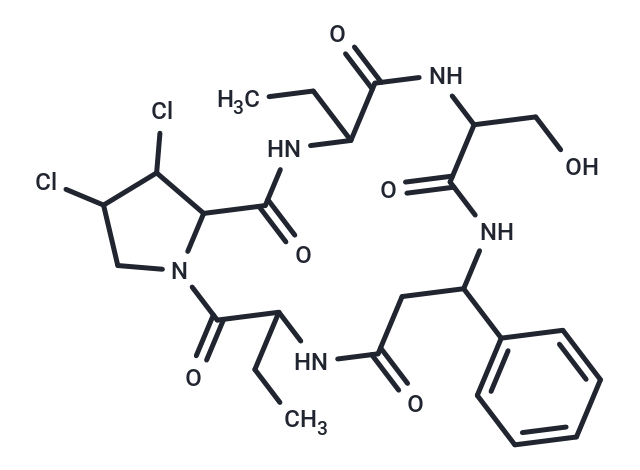Shopping Cart
Remove All Your shopping cart is currently empty
Your shopping cart is currently empty
Astin C (Asterin), a naturally occurring cyclic peptide that can be extracted from Aster tataricus, specifically blocks IRF3 recruitment at the STING signalosome inhibiting cGAS-STING signaling and innate inflammatory responses triggered by cytoplasmic dna, resulting in mice that are more susceptible to HSV-1 infection and significantly attenuating autoinflammatory responses.


| Description | Astin C (Asterin), a naturally occurring cyclic peptide that can be extracted from Aster tataricus, specifically blocks IRF3 recruitment at the STING signalosome inhibiting cGAS-STING signaling and innate inflammatory responses triggered by cytoplasmic dna, resulting in mice that are more susceptible to HSV-1 infection and significantly attenuating autoinflammatory responses. |
| Targets&IC50 | Ifnb and Cxcl10 expression (IMR-90 cells via STING pathway):10.8 μM, Ifnb and Cxcl10 expression (MEFs via STING pathway):3.4 μM |
| In vitro | Astin C (10 μM, 6 h) inhibited the expression of DNA- or HSV-1–induced genes such as Ifnb and Cxcl10 in MEFs and IMR-90 cells, with IC₅₀ values of 3.4 μM and 10.8 μM respectively, indicating it is a STING pathway inhibitorp[1]. |
| In vivo | In Trex1⁻/⁻ mice, Astin C (1 mg/kg, i.v., every other day for 14 days) reduced inflammatory gene expression across multiple tissues, alleviated autoimmune-related pathology, and decreased activated CD8⁺ T cells, showing anti-inflammatory and immunoregulatory effects[1]. |
| Synonyms | Asterin |
| Molecular Weight | 570.47 |
| Formula | C25H33Cl2N5O6 |
| Cas No. | 148057-23-2 |
| Smiles | O=C1NC(C(=O)N2CC(Cl)C(Cl)C2C(=O)NC(C(=O)NC(C(=O)NC(C=3C=CC=CC3)C1)CO)CC)CC |
| Relative Density. | 1.46g/cm3 |
| Sequence | Cyclo({Abu}-Pro-{Abu}-Ser-{Oaa}) |
| Sequence Short | Cyclo({Abu}-P-{Abu}-S-{Oaa}) |
| Storage | keep away from moisture | Powder: -20°C for 3 years | In solvent: -80°C for 1 year | Shipping with blue ice/Shipping at ambient temperature. | |||||||||||||||||||||||||||||||||||
| Solubility Information | DMSO: 80 mg/mL (140.24 mM), Sonication is recommended. | |||||||||||||||||||||||||||||||||||
Solution Preparation Table | ||||||||||||||||||||||||||||||||||||
DMSO
| ||||||||||||||||||||||||||||||||||||
| Size | Quantity | Unit Price | Amount | Operation |
|---|

Copyright © 2015-2026 TargetMol Chemicals Inc. All Rights Reserved.